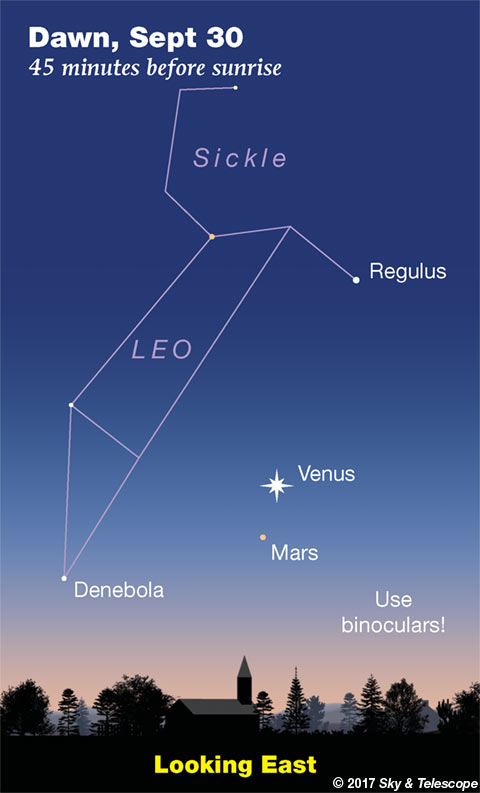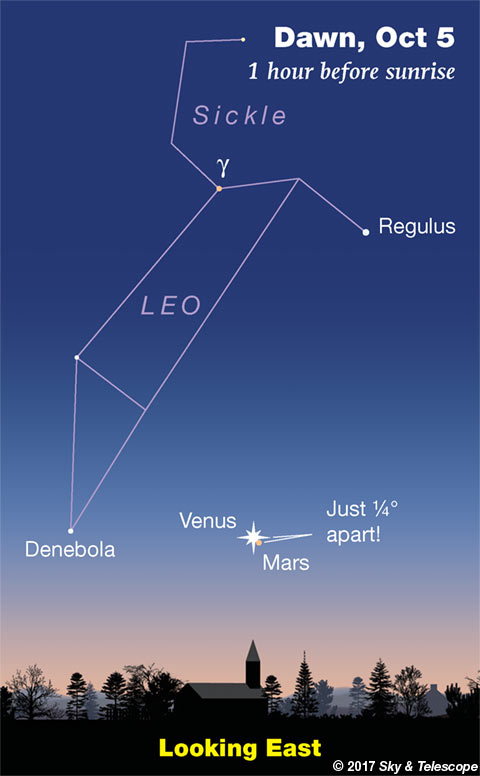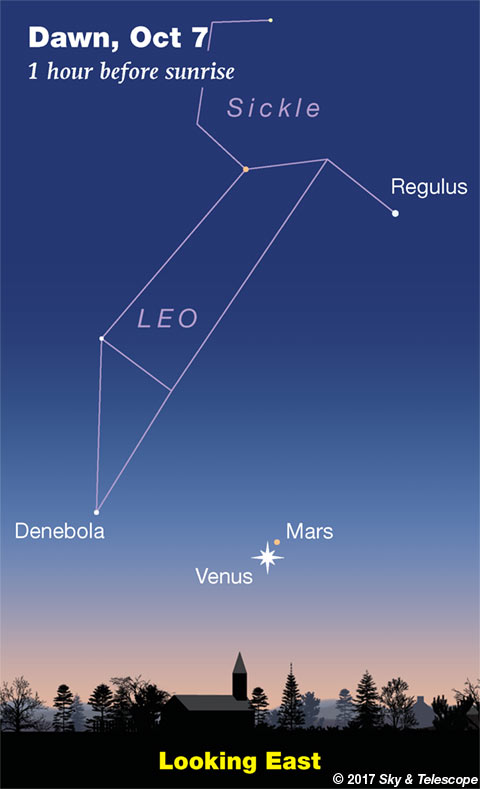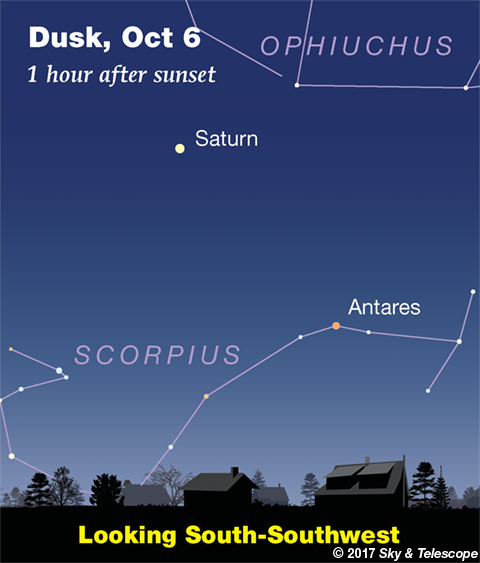


Friday, September 29
• As the stars come out in late twilight, look high above the Moon for Altair.
Once the sky is dark, examine the sky upper left of Altair for dim little Delphinus, the Dolphin, about a fist at arm's length from it.
A little less far straight above Altair is the smaller, dimmer constellation Sagitta, the Arrow. Binoculars will help.
Saturday, September 30
• Arcturus shines in the west these evenings, sinking as twilight fades away. Equally-bright Capella is rising lower in the north-northeast, depending on your latitude. (The farther north you are the higher it will be.) They're both magnitude 0, as bright as Vega high overhead.
By mid-evening Arcturus and Capella shine at identical heights. When exactly will this happen? That depends on both your latitude and longitude.
When it happens, turn around and look low in the south-southeast (well to the lower left of the Moon tonight). There you'll find 1st-magnitude Fomalhaut at the same height too — if you're at latitude 43° north. Seen from south of that latitude, Fomalhaut will be higher than Capella and Arcturus. Seen from north of there, it will be lower.
Sunday, October 1
• The starry W of Cassiopeia stands high in the northeast after dark. The right-hand side of the W (the brightest side) is tilted up.
Look along the second segment of the W counting down from the top. It's not quite horizontal. Notice the dim naked-eye star partway along that segment. That's Eta Cassiopeiae, magnitude 3.4, a Sun-like star just 19 light-years away with an orange-dwarf companion. It's a lovely binary pair in a telescope, with an easy separation of 20 arcseconds.
Left of Eta Cas along the segment is a fainter, much wider pair: Upsilon1 and Upsilon2 Cassiopeiae, separation 0.3° (1,200 arcseconds). This pair consists of two orange giants, and they're unrelated to each other; they're 200 and 400 light-years from us.
Monday, October 2
• After dark, look low above the northeast horizon — far below Cassiopeia — for bright Capella on the rise. How high you'll find it depends on your latitude. The farther north you are, the higher it will be.
Tuesday, October 3
• Vega is the brightest star very high in the west at nightfall. Arcturus, equally bright, is getting low in the west-northwest. The brightest star in the vast expanse between them, about a third of the way from Arcturus up toward Vega, is Alphecca, magnitude 2.2 — the crown jewel of Corona Borealis. Alphecca is a 17-day eclipsing binary, but its brightness dips are too slight for the eye to see reliably.
Wednesday, October 4
• Venus and Mars are in conjunction in early dawn tomorrow, forming a tight pair; they're only about ¼° apart during dawn for the Americas. Look low in the east. Binoculars or a low-power telescope will help separate the dazzle of Venus from the dimmer lights of Mars (magnitude 1.8) and nearby Sigma Leonis (even fainter at magnitude 4.0, not shown on the scenes here).
Thursday, October 5
• Full Moon (exactly full at 2:40 p.m. EDT). The Moon rises due east around sunset. After dark, as the Moon gains height, look above it for the Great Square of Pegasus balancing on one corner.
• NEPTUNE'S MOON TRITON OCCULTS A STAR. Early Thursday evening for the eastern US and Canada, Neptune’s large satellite Triton will occult a 12th-magnitude star in Aquarius. "The star, which is about a magnitude brighter than Triton, is the brightest to be blocked by Triton since the Voyager 2 spacecraft flew by in 1989," writes David Dunham, "giving us a rare opportunity to study the Pluto-like moon’s atmosphere. The occultation occurs around 7:55 p.m. EDT, when Neptune/Triton will be about 25° above the horizon in the southeast as seen from the Eastern coast of the United States." See Dunham's article. "Amateurs interested in recording the event should use a camera capable of recording single frames that can then be calibrated using (at the very least) flats and bias frames."
MIT has set up a website for this observing campaign. Dunham has issued protocols for observers of this event, updated protocols with more information for US observers, and a report form.
Friday, October 6
• The Moon, just past full, rises in the east in late twilight. As night arrives, look for the two brightest stars of Aries to the Moon's upper left by about a fist and a half at arm's length. The stars are 4° apart (less than half a fist) and lined up almost horizontally. Can you see that the brighter one — Hamal, on the left — has an orange tint?
Saturday, October 7
• The Great Square of Pegasus balances on its corner high in the east at nightfall. For your location, when it is exactly balanced? That is, when it the Square's top corner exactly above its bottom corner? It'll be sometime after the end of twilight, depending on both your latitude and longitude. Try lining them up with the vertical edge of a building for improved precision.
________________________
Want to become a better astronomer? Learn your way around the constellations! They're the key to locating everything fainter and deeper to hunt with binoculars or a telescope.
This is an outdoor nature hobby. For an easy-to-use constellation guide covering the whole evening sky, use the big monthly map in the center of each issue of Sky & Telescope, the essential guide to astronomy.

Once you get a telescope, to put it to good use you'll need a detailed, large-scale sky atlas (set of charts). The basic standard is the Pocket Sky Atlas (in either the original or Jumbo Edition), which shows stars to magnitude 7.6.
Next up is the larger and deeper Sky Atlas 2000.0, plotting stars to magnitude 8.5; nearly three times as many. The next up, once you know your way around, is the even larger Uranometria 2000.0 (stars to magnitude 9.75). And read how to use sky charts with a telescope.
You'll also want a good deep-sky guidebook, such as Sue French's Deep-Sky Wonders collection (which includes its own charts), Sky Atlas 2000.0 Companion by Strong and Sinnott, or the bigger Night Sky Observer's Guide by Kepple and Sanner.
Can a computerized telescope replace charts? Not for beginners, I don't think, and not on mounts and tripods that are less than top-quality mechanically (meaning heavy and expensive). And as Terence Dickinson and Alan Dyer say in their Backyard Astronomer's Guide, "A full appreciation of the universe cannot come without developing the skills to find things in the sky and understanding how the sky works. This knowledge comes only by spending time under the stars with star maps in hand."
This Week's Planet Roundup

Mercury is hidden behind the glare of the Sun.
Venus is the brilliant "Morning Star," (magnitude –3.9) low due east in the dawn. This week it sinks down past faint Mars, magnitude +1.8, only 1/200 as bright. They appear closest together on the morning of October 5th, as shown in the panels above (drawn for North America).
Whenever Mars appears anywhere near Venus, it seems to get scared and fade. That's because Venus is never seen far from our line of sight to the Sun. Whenever Mars is anywhere near our line of sight to the Sun, it has to be on the far side of its orbit from us: about as far and faint as it gets.
Jupiter has disappeared into the sunset.
Saturn (magnitude +0.5, in Ophiuchus to the right of Sagittarius) glows low in the southwest at nightfall, as shown here. It soon sinks lower and sets.
Uranus (magnitude 5.7, in Pisces) and Neptune (magnitude 7.8, in Aquarius) are up in the east and southeast, respectively, by mid- to late evening. Use our finder charts.
______________________
All descriptions that relate to your horizon — including the words up, down, right, and left — are written for the world's mid-northern latitudes. Descriptions that also depend on longitude (mainly Moon positions) are for North America.
Eastern Daylight Time (EDT) is Universal Time (UT, UTC, GMT, or Z time) minus 4 hours.
______________________
"This adventure is made possible by generations of searchers strictly adhering to a simple set of rules. Test ideas by experiments and observations. Build on those ideas that pass the test. Reject the ones that fail. Follow the evidence wherever it leads, and question everything. Accept these terms, and the cosmos is yours."
— Neil deGrasse Tyson, 2014
______________________
"Objective reality exists. Facts are often determinable. Carbon dioxide traps global heat. Vaccines save lives. Bacteria evolve to thwart antibiotics, because evolution. Science and reason are not a political conspiracy. They are how we discover reality. Civilization's survival depends on our ability, and our willingness, to do so."
— Alan MacRobert, your Sky at a Glance editor
______________________
"Facts are stubborn things."
— John Adams, 1770
 2
2








Comments
Anthony Barreiro
September 29, 2017 at 6:08 pm
Hmm, I never thought about the fact that Mars always fades in Venus' presence. If you'll excuse a bit of astrology, I hope this conjunction will be a good omen for the power of love to overcome conflict.
You must be logged in to post a comment.
Alexander Vasenin
September 30, 2017 at 8:23 am
Actually Archid separation is 13" http://stelledoppie.goaction.it/index2.php?iddoppia=3224
You must be logged in to post a comment.
You must be logged in to post a comment.